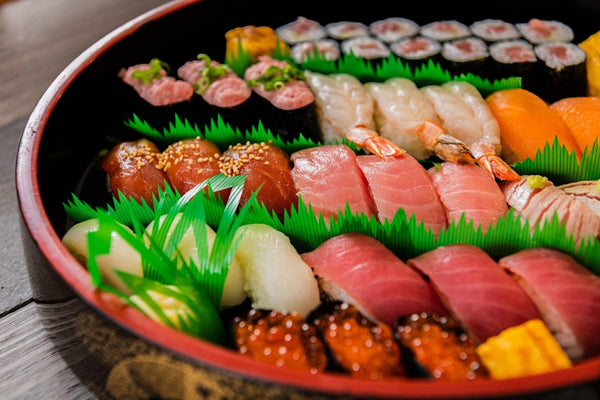
Jump to:
Sushi is one of the most popular Japanese foods enjoyed around the world nowadays.
But for the novice, sushi – with its myriad forms and flavors – might seem a little intimidating.
No worries! We’ve created this guide to help you navigate the wonderful cuisine of sushi, from the classic nigiri sushi to the lesser-known varieties that might just become your new favorites.
What Is Sushi? Just Rice & Raw Fish?

At its core, sushi is a dish that combines vinegared rice with various ingredients, often including raw fish, vegetables and sometimes fruits or meat.
But calling sushi just "rice and fish" is like saying a symphony is just "notes and instruments.” It misses the artistry, tradition and sheer deliciousness of this beloved Japanese cuisine.
The word "sushi" actually refers to the vinegared rice, not the fish or other toppings. This rice, known as shari, is the foundation of all sushi dishes. It's typically short-grain Japanese rice, seasoned with a mixture of rice vinegar, sugar and salt. This subtle flavoring is crucial – it complements the fish and other ingredients without overpowering them.
Sushi has come a long way from its simple beginnings as a method of preserving fish.
Today, sushi is a global phenomenon, with countless variations that blend standard sushi techniques with local ingredients and contemporary tastes. Sushi continues to evolve. In Japan, sushi has to maintain its essence of simplicity and balance. Outside Japan, the boundaries of sushi are being pushed.
In this article, we’ll talk about sushi both in Japan and beyond its borders. So if you see something and think, “hey, that’s not real/pure/legit sushi,” you’re not wrong. But we’re looking at the whole world of sushi, exploring traditional sushi as well as its modern relatives.
Types Of Sushi
Let’s start with a rundown of the many types of sushi. We’ll begin with the more “traditional” (for lack of a better word) sushi essentials, then move into some newer sushi variants.
Nigiri Sushi

Nigiri, often considered the “purest form of sushi,” is a small mound of vinegared rice topped with a slice of raw fish or seafood.
The word "nigiri" means "to grasp" or "to squeeze," referring to the way the sushi chef shapes the rice with their hands.
When you bite into a piece of nigiri, you should be experiencing a balance of flavors and textures. The warm, slightly tangy rice provides a soft base for the cool, silky fish. A dab of wasabi could be hiding between the rice and fish, adding a subtle kick.
Popular Nigiri Types
Here are some of the favorites when it comes to nigiri sushi.
- Maguro (tuna): The classic. Rich, meaty and melt-in-your-mouth delicious.
- Sake (salmon): Buttery and mild, it's a favorite for sushi newbies and veterans alike.
- Hamachi (yellowtail): Slightly fatty with a delicate flavor.
- Unagi (freshwater eel): Always served cooked and brushed with a sweet soy-based sauce.
- Tamago (egg): A slightly sweet omelet that's a great option for those wary of raw fish.
Makizushi

Makizushi is what many people picture when they think of “sushi rolls.” Makizushi literally means “rolled sushi” – it is made by wrapping sushi rice and fillings in nori (seaweed) and then generally cutting the roll into bite-sized pieces. There are several types of makizushi:
Futomaki: These are thick rolls, usually containing two or more fillings. They're often vegetarian, making them a great choice for plant-based eaters.
Hosomaki: Thin rolls with just one filling, like cucumber (kappa maki), tuna (tekka maki) or even avocado rolls. Simple, but delicious.
Uramaki: "Inside-out" rolls where the rice is on the outside and the nori is on the inside. The California roll is a famous example. These sushi rolls are more common outside Japan.
Temaki: These are the “hand rolls,” which can contain pretty much any filling you’d find in the other rolls, but are bigger and rolled to resemble an ice cream cone in shape.
Popular Sushi Rolls: Big Beyond Japan

When it comes to sushi rolls, the ones you’d typically see in Japan are hosomaki, futomaki and temaki.
There are, however, a wide variety of sushi rolls that are popular outside Japan. These are typically made as temaki or uramaki (inside out) rolls.
- California Roll: Crab (or imitation crab), avocado and cucumber. It's the gateway roll for many sushi beginners. This roll was invented in (you guessed it) California, more than a half century ago, when sushi chefs looked to sub out tuna for more locally available ingredients. They discovered that the combination of avocado and crab, dipped in soy sauce, felt and tasted rather familiar… like tuna.
- Spicy Tuna Roll: Tuna mixed with spicy mayo, often with cucumber for crunch.
- Dragon Roll: Usually an eel and cucumber roll topped with avocado to resemble dragon scales.
- Rainbow Roll: A California roll topped with various types of fish, creating a colorful "rainbow" effect.
Again, this list directly above is a reflection of how sushi has evolved outside Japan. While there are some sushi shops in Japan (either modern style or in touristy areas) offering these rolls, most Japanese people would view these “sushi rolls” as American or foreign in iteration.
Chirashizushi

Think of chirashizushi as a sushi bowl. It's a bed of sushi rice (vinegared) topped with a variety of sashimi and other ingredients like cucumber, shiitake mushrooms and shredded egg. It's like a deconstructed sushi roll, perfect for those who want to enjoy all the flavors of sushi in a more casual format.
If you’ve had kaisendon in Japan or elsewhere, it’s pretty similar to chirashi sushi, only kaisendon doesn’t use vinegared rice.
Inarizushi

For a sweet and savory treat, try inarizushi. It's sushi rice stuffed into pouches of fried tofu (inari) that have been simmered in a sweet soy sauce. The result is a lovely contrast between the sweet, slightly oily tofu and the tangy sushi rice.
If the inari in this form of sushi sounds like “Fushimi Inari,” the popular and beautiful shrine in Kyoto, that’s no coincidence! These sushi typically have been offered to the gods at inari shrines (shinto) across Japan for generations, praying for a good harvest.
Temarizushi

Temarizushi, or "ball sushi," are small, round balls of sushi rice topped with fish or other ingredients. They're named after temari, a type of Japanese handball, due to their spherical shape. These cute, bite-sized morsels are often served at parties or made for children because of their fun appearance.
Gunkan Maki

Gunkan maki, which means "battleship roll," is a type of sushi that consists of a small ball of rice wrapped with a strip of nori and topped with various ingredients. The nori extends above the rice, creating a "vessel" that can hold looser toppings.
Popular Gunkan Maki Types:
- Ikura (salmon roe): The bright orange eggs pop in your mouth, releasing a burst of briny flavor
- Uni (sea urchin): A creamy, golden delicacy with a rich, ocean flavor
- Negitoro: Chopped fatty tuna mixed with green onions, a luxurious treat
Getting hungry reading this? So are we! But let’s keep moving through the sushi list.
Narezushi

Narezushi is the ancestor of modern sushi. It's made by fermenting fish with rice and salt, resulting in a pungent, cheese-like flavor. While not commonly found in sushi restaurants, it's an interesting glimpse into sushi's origins.
Oshizushi

Oshizushi, or "pressed sushi," is made by layering sushi rice and toppings in a special box called an oshibako, then pressing it to create a compact, layered block of sushi that's cut into rectangles. It's a specialty of Osaka and makes for a visually striking presentation.
Nigiri vs Sashimi: What's The Difference?
While both nigiri and sashimi showcase fresh, raw fish, there's a key difference: rice vs no rice.
Nigiri is a slice of fish served atop a small mound of sushi rice.
Sashimi is simply raw fish, served without rice.
Sashimi is all about appreciating the pure flavor and texture of the fish. It's typically served with soy sauce for dipping, and you might find a small mound of wasabi and some shredded daikon radish on the side.
Nigiri, on the other hand, is about the harmony and balance that exist between the fish and the seasoned rice. The rice isn't just a base; it's an integral part of the flavor profile.
Both are delicious in their own right, and which one you prefer often comes down to personal taste. Sashimi might appeal more to purists and those watching their carb intake, while nigiri offers a more complete, balanced bite.
Sushi Rolls vs Hand Rolls: Understanding The Distinction
While both sushi rolls (makizushi) and hand rolls (temaki) involve wrapping ingredients in nori, they differ in shape and eating experience.
Sushi rolls are cylindrical and cut into bite-sized pieces. They're designed to be eaten in one or two bites and are great for sharing.
Hand rolls, on the other hand, are cone-shaped and meant to be eaten immediately after being made, while the nori is still crisp. They're larger than sushi rolls and are eaten like an ice cream cone. Hand rolls offer a more casual, interactive sushi experience and are often made to order right in front of you.
Making Sushi at Home & Enjoying Sushi in Japan
Want to make sushi at home?
We’ve got an article on sushi recipes for you, as well as another guide on throwing the ultimate sushi party.
If you’re traveling to Japan, you’ve got a vast range of sushi establishments catering to your desires.
We recommend starting at a kaiten-sushi or conveyor belt sushi restaurant. These come in the form of local eateries as well as national & regional conveyor belt sushi chains.
Once you’ve had these, you can start working your way up the sushi ladder, going to “proper” sushi restaurants at different price levels, possibly ending up at a “omakase” high end sushi restaurant (some of which even have Michelin stars).
Sushi Evolution, From Simple To Exotic

Indeed, the world of sushi is vast and varied, with something to suit every palate.
From the simplicity of nigiri and the creativity of modern rolls, to the traditional narezushi and convenient chirashizushi, sushi continues to evolve while maintaining its core principles of fresh ingredients and balanced flavors.
So next time you're at a sushi restaurant, why not step out of your comfort zone? Try a type of sushi you've never had before. You might just discover a new favorite!
Have you enjoyed sushi in Japan before? Do you have a favorite kind of sushi? Let us know in the comments below.


0 comments